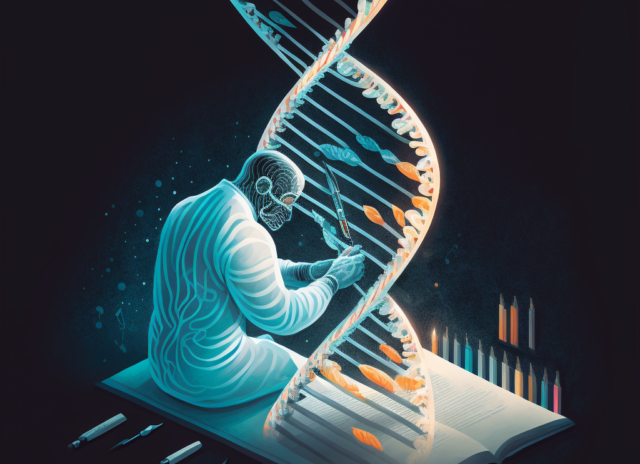

The six-day creation story of Genesis one has always been at the very centre of the science-faith debate. In this article Emeritus Professor Carolyn King explains how an understanding of ancient cultures can bridge the divide over this key biblical text.
Originally published in The Melbourne Anglican.
ISCAST opinion articles invite writers to share their perspectives on various science–faith topics to generate a constructive conversation. While ISCAST is committed to orthodox Christian faith and mainstream science, our writers may come from a range of positions and do not represent ISCAST.
Much of the perceived science–religion conflict is based on centuries of imposing our own cultural assumptions upon ancient texts, and on a failure to ask the right questions about what they were originally about.
Preliterate cultures passed their ancient knowledge down the generations in the form of easily memorable stories, later written down into what became authoritative Scripture. The book of Genesis is the product of long, slow years of development of ancient oral traditions dating back to at least 1200–1000 BC. The oldest written version, dating to 950–850 BC and known as the Old Epic, is preserved in Genesis chapters 2-11. By contrast, Genesis 1 is a literary work dated to around 550 BC.
Understanding the Long Shadow of Ancient Cosmology
Our materialist assumptions about how the universe works colour our thinking in ways we seldom recognise, and which were certainly completely unknown to the authors of Genesis. We leap to the conclusion that Genesis 1 is describing the origin of the material universe, because we can’t see how else it could be read. We assume that the apparent contradiction between Genesis 1 and evolutionary science is because the biblical writers were ignorant of science, and their story can be dismissed as a fable.
But those who take the trouble to understand how ancient cultures actually thought about the world tell us that the real primary concern of Genesis 1 was quite different. Hebrew theologians did not ask, “How was the world made?” but rather “What is it for?”.
In John Walton’s illuminating book The Lost World of Genesis One, he shows us how asking the right questions about the original meaning of this primary text removes all reasonable grounds for the modern dispute. Genesis 1 does not contradict science—it is not about science. On the contrary, it is concerned only to assert the Hebrew belief in the authority of God overruling the cosmologies common to all cultures of 3000 years ago. Pagans saw the universe as created by multiple deities for their own pleasures, and the human population as living in slavery and fear of them. Contrary to that, Genesis 1 is a masterly statement of the Hebrew belief in a world created by one, all-powerful and loving deity specifically for the benefit of human creatures capable of enjoying and caring for it.
Appreciating the Internal Logic of Genesis 1
The logic is very clear when the six days are arranged in two columns of three. Reading down the columns from days one to three shows the creation of functional spaces in order. They provide the bases of time (day and night), weather (water and sky), and food (land and vegetation). Then, on days four to six, those functional spaces are filled with their inhabitants. On day four, the sun, moon, and planets appear, responsible for providing the visible markers of time. On day five, the waters and the sky are inhabited by fish and birds, and commanded to be fruitful and multiply. On day six, the land and vegetation are occupied by beasts, whose function is to serve humans, and people, who have the responsibility to care for the earth and its inhabitants.
In short, Genesis 1 insists that the sun, moon, and stars are creatures, not gods, and are certainly not to be worshipped. The dome of the sky was seen as a solid firmament, with windows to let through the rain, and fixed tracks along which the sun and the planets moved. The heavens and their inhabitants were created to serve humanity by marking the passing of the days and seasons and by helping us to organise the annual rounds of planting and harvesting.
Walton helpfully compares the sequence of divine actions described in Genesis 1 with the building of a new school in six stages. In this analogy, the school designers first set out the structure, so at stage one they need light on their plans. At stages two and three they build all the required functional spaces, such as classrooms, library, gym, offices, gardens, playing fields and a pool. Only when these are ready can those spaces be populated with inhabitants. At stage four, electric lights, power points, clocks, and internet connections, at stage four, aviaries, terraria for frogs and lizards, aquaria, and fishponds, and finally at stage six, pupils and staff.
The authors of Genesis 1 saw no need to describe the material origins of the earth, because everything was simply assumed to have been made by God. The questions we ask of the text, such as, how could there have been light on the first day when the sun did not appear until the fourth day, would have been pointless and incomprehensible to those for whom it was written.
The few places where Genesis 1 apparently agrees with science, at least to some extent –such as placing the arrival of humans last on the six-day sequence of events, after the vegetation and the animals—are not proof of an inspired pre-vision of cosmic history as we understand it now. Genesis 1 is not and never was intended to explain the material origins of the universe in terms that have any relevance to our scientific knowledge. Only much later did philosophers begin to suspect there could be more to see behind the solid firmament of the sky.
Read with understanding of its original intent, Genesis 1 does not contradict science at all. It is not about science. On the contrary, it is set out as a text for congregational participation in a joyful annual festival. It has rhythmic wording suitable for group speaking, it has a strong emphasis on the world designed as home for people, and is regularly punctuated by choruses proclaiming that “… it was good.” (In the context, “good” means fit for purpose, not morally good). So the most likely original context of Genesis 1 is as the text for a literal seven-day festival celebrating the inauguration of the cosmic temple, like the one for the inauguration of Solomon’s temple described in 2 Chronicles 7:8.
It is hard for us to cast off our materialist assumptions and step out of our world into that of 3000 BC. But if we do that, we discover that Genesis 1 frees us from any need to choose between a religious belief versus contemporary science for explanations of the world around us. It does not deny a religious assertion that God made material creation, only that Genesis 1 is not about that story. It does not deny evolution, or that the material universe evolved long before humans; rather, it assumes that the long procession of pre-human creatures helped to prepare the earth for humans. Since Genesis 1 never was about material origins, there is no conflict with science. The tragic science-religion war was never necessary.














